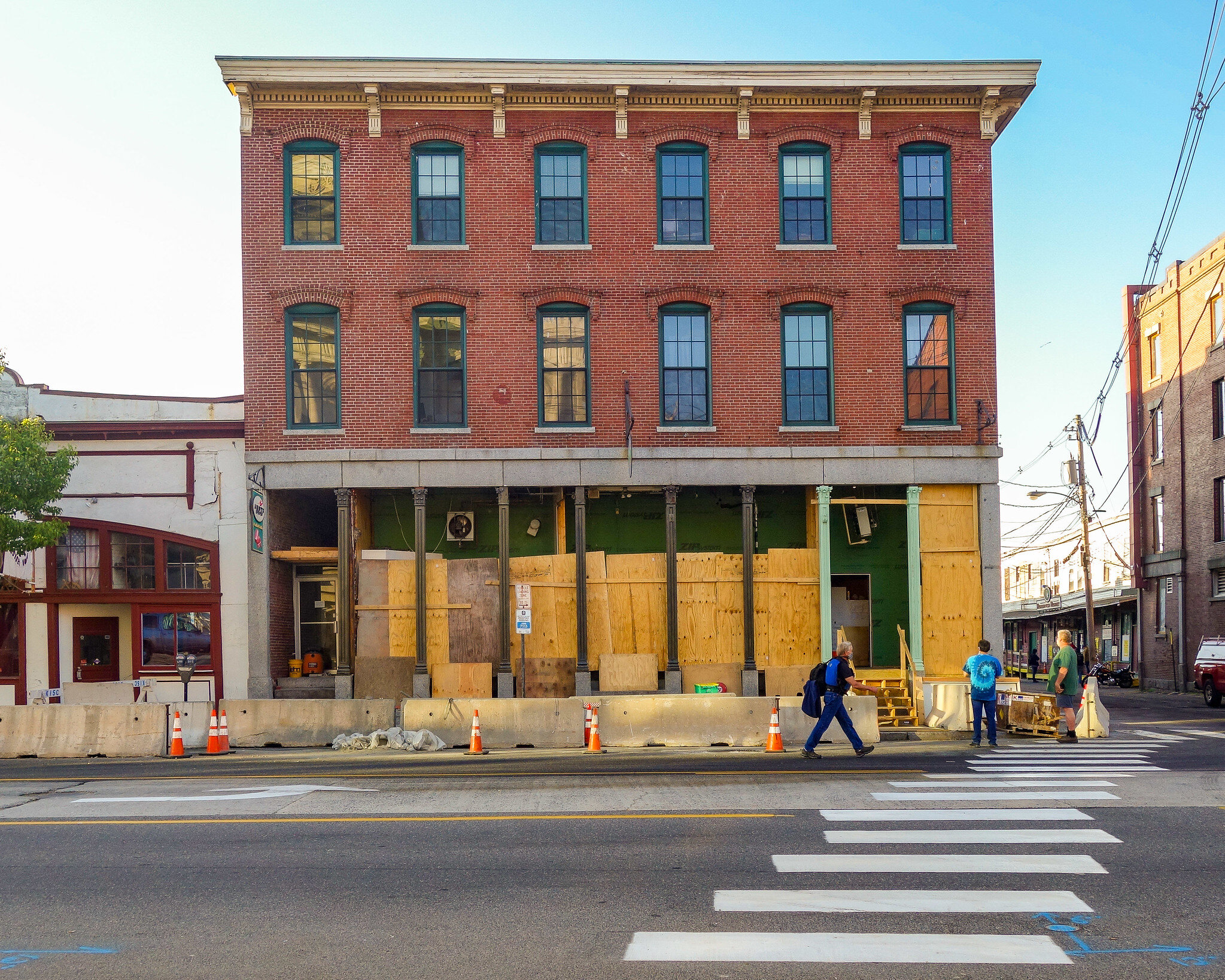Exchange Street in the Old Port Historic District (Photo by Corey Templeton)
By Mark McDonnell, 2020 Intern
Each summer, Greater Portland Landmarks hires interns currently enrolled in historic preservation programs at colleges across the country to assist in our advocacy and education work. Our interns bring their knowledge of the preservation world in academia and in other parts of the country. In return, they gain valuable experience working in a historic preservation non-profit. This year, they’re working remotely.
Mark was raised in New Jersey and is enrolled in the Preservation Studies M.A. program at Boston University.
What is a Local Historic District?
Historic districts fall under two major types: National Register Historic Districts (NRHDs) and Local Historic Districts (LHDs). LHDs protect and regulate the buildings within them, while NRHDs are more useful for identifying historic resources and securing federal funding for rehabilitation of these structures. The impact of a LHD on the homeowner can be greater than that of the NRHD, but there are some similarities. For example, both types of historic districts can promote tourism. The NRHD might seem more appealing to the homeowner because it lacks the regulatory power of the LHD, but LHDs offer plenty of benefits as well, and common concerns about their negative impacts do not hold up against the data.
Local historic districts (LHDs) are defined and regulated areas containing groups of properties that have been determined to contribute to a municipality’s culture or heritage. Generally, street-facing facades of buildings in LHDs cannot be significantly altered, but interior changes and exterior alterations not visible to the public are usually approved by the LHD’s regulatory body. Local historic districts preserve the historic character of an area with tools such as demolition delay and design review. Likewise, new construction in or near a LHD might be subject to design requirements or otherwise be encouraged to be compatible with nearby historic construction. Living in a LHD can provide environmental and economic benefits, among others.
Environmental Benefits
Rehabilitating a building on Commercial Street in the Old Port Historic District (Photo by Corey Templeton)
Local historic districts benefit the environment by maintaining and reusing historic buildings rather than demolishing and replacing them. Using an already-existing building is better for the environment than new construction, even if the new construction would be energy efficient. Reusing an existing building that has outlived its original purpose is called “adaptive reuse.” Adaptive reuse is almost always better for the environment than new construction because fewer materials need to be made, transported, or assembled. Local historic districts are inherently “green” because they encourage the use and reuse of already-existing buildings rather than demolition and new construction.
Economic Benefits
Economic benefits of owning a home in a local historic district are well-documented, contrary to popular concerns that regulations governing a LHD might lower property values. In fact, property values in historic districts appreciate faster than in surrounding areas that are not designated historic districts. “City or regional studies where historic districts are compared to non-historic districts have provided generally conclusive data regarding the history of property value increases over time in historic districts that exceed the rate of growth in non-historic districts.”[1] For example, a 2011 study of single-family homes in Connecticut towns, conducted by the Connecticut Trust for Historic Preservation, found, “Overall there appears to be a 2-4% value premium from location within a local historic district.”[2] This positive effect on property values is exaggerated in urban areas. In New York City, the value premium ranges from 8% in the bottom quantile of house prices to 5% in the highest.[3]
A snowy day in the Deering Street Historic District (Photo by Corey Templeton)
While property values appreciate faster in historic districts than outside them, there is no evidence that this causes gentrification or other displacement, despite several studies evaluating exactly this possibility. The largest of these studies found that “nothing happens” regarding demographic changes connected to historic designation. Any demographic change that occurs in the area within a decade of historic designation, the authors conclude, is unrelated to the historic designation.[4]
Historic districts offer economic and environmental benefits. Using and reusing existing buildings is a major environmental, and potentially financial, benefit in itself. Likewise, the positive effect of historic district designation on property values is well established, despite common concerns about regulations. Historic districts preserve a town or neighborhood’s historic character while providing many important benefits to their residents and to the environment.
References
[1] Mimi Morris, “The Economic Impact of Historic Resource Preservation,” California Cultural and Historical Endowment, November 2012: 13, https://resources.ca.gov/CNRALegacyFiles/docs/cche/EconomicImpact_of_HistoricResourcePreservation.pdf.
[2] PlaceEconomics, “Connecticut Local Historic Districts and Property Values,” Connecticut Trust for Historic Preservation, October 2011: 3, http://lhdct.org/documents/Property%20Values%20LHD%202011.pdf.
[3] Edward L. Glaeser, “Preservation Follies: Excessive Landmarking Threatens to Make Manhattan a Refuge for the Rich,” City-Journal, Spring 2010, https://www.city-journal.org/html/preservation-follies-13279.html.
[4] N. Edward Coulson and Robin M. Leichenko, “Historic Preservation and Neighbourhood Change,” Urban Studies 41, no. 8 (July 2004): 1587, https://buprimo.hosted.exlibrisgroup.com/permalink/f/g23ind/TN_sage_s10_1080_0042098042000227028.
Further Reading
“National Park Service Historic Preservation Economic Impact.” National Park Service. Updated January 11, 2015, https://www.nps.gov/subjects/historicpreservation/economic-impacts.htm.
Rypkema, Donovan, Caroline Cheong, and Randall Mason. “Measuring Economic Impacts of Historic Preservation: A Report to the Advisory Council on Historic Preservation.” November 2011. https://www.achp.gov/sites/default/files/guidance/2018-06/Economic%20Impacts%20v5-FINAL.pdf.
Zahirovic, Velma, and Swarn Chatterjee. “Historic Preservation and Residential Property Values: Evidence from Quantile Regression.” Urban Studies 49, no. 2 (February 2012): 369-382. https://buprimo.hosted.exlibrisgroup.com/permalink/f/g23ind/TN_sage_s10_1177_0042098011404936.



